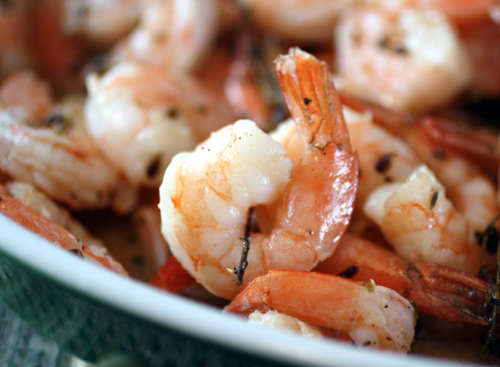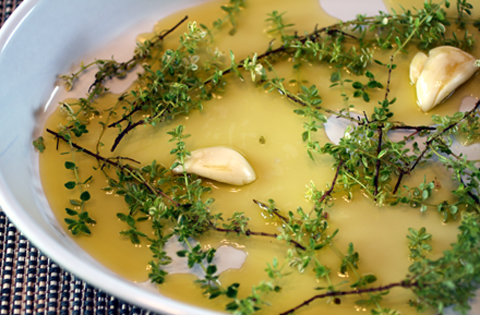Embracing High Heat, Part I (The Savory)

I dunno about you, but in my early days of cooking, I was petrified of high heat.
Back then when I was a teen, the words, “Heat the pan on high,” would make me quake in fear.
I thought I’d end up burning myself, not to mention whatever I was cooking, along with the poor pan, too.
But the more you cook, the more you realize the beauty of high-heat cooking. There’s nothing like it for creating caramelization, and thus, greater flavor, texture, and color.
Who doesn’t love the blistered crust of pizza baked in a scorching wood-oven? Or the yummy crust on a seared steak? Or the crispy skin on a salmon fillet? Or the smoky, intense flavor vegetables get from being tossed around in a fiery wok?
When I took a recent class at Draeger’s in San Mateo, veteran cookbook authors Bruce Weinstein and Mark Scarbrough reminded me of the joy of high-heat cooking, when they demonstrated their recipe for “Roasted Shrimp.” It’s from their newest cookbook, “Cooking Know-How” (Wiley).
Normally, I just saute shrimp in a pan. But their oven-method could not be easier. It’s my new favorite way to cook shrimp.
Like all the recipes in this book, the shrimp one gives you a basic technique, then variations so you can alter the flavorings.

The method remains the same: You put a baking dish in a cold oven with oil and herbs. Turn the oven on to 450 degrees. As it warms, the herbs get infused gently into the oil. When the oven gets up to temperature in 15 to 20 minutes, add shrimp (or scallops) to the pan. Cook for about 10 minutes for large shrimp (about 5 minutes for scallops), stirring a couple of times during the cooking process.
Pull out the pan, then stir in salt, pepper, and a dash of acid (vinegar, citrus juice, or wine).
This is by far the juiciest shrimp you’ll ever eat, with a pleasing crunch, too. It’s the high heat that does all that. Moreover, the fragrance of the herbs roasting in the oven is utterly intoxicating.
Serve the shrimp as an appetizer, or as an entree with salad and crusty bread. The shrimp also would be phenomenal over pasta.
Below is the recipe for “Thyme Roasted Shrimp,” which is the variation I made. I also used lemon thyme instead of regular, because I happen to have a pot of it growing in my yard. Also included are directions to make the variation, “Rosemary Roasted Shrimp,” which Weinstein and Scarbrough demonstrated.
Once you get the technique down, feel free to experiment with your own flavor combos.
Then, kiss your fear of high heat good-bye.
Thyme Roasted Shrimp
(serves 4)
1/4 olive oil
12 thyme sprigs
2 peeled whole garlic cloves
2 pounds large shrimp (about 18 per pound), peeled and deveined
2 tablespoons balsamic vinegar
1 teaspoon salt
1/2 teaspoon ground black pepper
Pour olive oil into a 9-by-13-inch baking dish or similarly sized roasting pan.
Add thyme sprigs and garlic to the dish. Set the dish in the oven, then preheat the oven to 450 degrees for 15 to 20 minutes.
Lay shrimp over the thyme and garlic,then roast until pink and firm, about 8 minutes for medium shrimp (about 30 per pound) or 10 minutes for large shrimp (about 18 per pound), tossing gently two or three times.
Remove baking dish from the oven, and stir in vinegar, salt, and pepper. Serve.
Variation: To make Rosemary-Roasted Shrimp, substitute 5 rosemary sprigs for the thyme, and 2 tablespoons white wine vinegar for the balsamic.
From “Cooking Know-How”
Tomorrow: Embracing High Heat, Part II (The Sweet)

That is really interesting – it must smell wonderful, too!
My hubby is crazy for shrimp, gotta make these for him!
A wonderful combination! Perfect for the hot summer days!
Cheers,
Rosa
I love high heat, don’t think I have every tried high-roasted shrimp. Good idea!
Did you see the new way to achieve 800 degrees for pizza? Without building yourself an oven? Clever idea. http://feedme.typepad.com/my_weblog/2009/06/pizza-heat.html
Grand! I love the ingredients I bet the Aroma is so Amazing. Perfect for the summertime ~
Thanks for sharing your reicpe ~
Have a Sunny Day~
Thanks so much, Carolyn, for posting this recipe from the book. I have to admit–it’s one of my favorites. But you did leave something out. The necessary pitcher of daiquiris, of course! Total deck food.
.. che bellol .. come sei contenta..
Sounds like a delicious way to prepare shrimp or scallops. The herb-flavored oil sounds great.
Without having access to the author’s introductory material, it is difficult to know how much “science†they include in their theories. Essentially, the shrimp are being roasted (a slow heat transfer method that mostly relies on convection currents in the oven) rather than stir-fried (a fast heat transfer method that that relies on conducted heat). There is also a radiated component in both methods, how much depends upon many factors. Although the oven is at a relatively hot temperature, the rate of cooking is slower than with stir-frying. Also, significantly more energy is used in the cooking process and the whole dish takes longer to prepare. Because it takes longer to cook, the shrimp are less likely to become overcooked and therefore remain juicier and tender longer. Earlier I wrote that the shrimp are being roasted, but that is too simple. The shrimp near the bottom of of the baking dish are being shallow-poached in oil—a method similar to confit but with less fat—and those above the oil are being roasted.
It sounds amazing and I look forward to giving it a try — I love shrimp in just about any form so you had my attention from my first peek at the pic!
Draegers! bay area memories coming back. The herbal bath looks beautiful – alone in itself looks like a portrait
I can just imagine the delicious flavor thyme adds to the shrimp! Excellent!
I was a little afraid of my Dacor stove when I first got it, the heat gets super high on this one!
That looks so good! I’ve got to try it tomorrow. Now I have some use for that giant thyme plant growing in my herb garden. Gotta try it with the rosemary too! Oh, yummy. I can smell it already!
Pingback: Roasted Shrimp with Tomato Vinegar « FoodMayhem
Omg. I normally don’t like to eat shrimp, but your recipe makes me want to try making some for my family! Thanks for posting it up. High heat really does scare me (as i’m still a teen), but hopefully i’ll get over it soon so this scrumptious dish can end up on the dinner table for all to enjoy :]
Kelley: Have no fear. I’m sure you’ll grow out of your high-heat fright, just as I did. You already have a good head start on it, too. You’re a teen, and you’re already cooking. That’s something to be proud of. I think your family will be proud and delighted to have you make this dish. Just use a good oven mitt, and you’ll be fine.
It has taken me years to turn up the heat; up until then, my food tended to be rather pale and soggy for lack of that searing, sealing high temperature. What a wonderful and quite straightforward technique that lends itself so well to creative flavor combos. Wonder if I can come up with something different?
Pingback: shrimp pesto pizza | Spicy Recipes
Pingback: Shrimp Scampi Pizza | Spicy Recipes
Pingback: Taco Pizza | Spicy Recipes
Pingback: French Quarter Sausage, Red Beans and Rice Pizza | Spicy Recipes
Pingback: Chicken Ranch Pizza | Spicy Recipes
Pingback: Vine Ripened Tomato Pizza | Spicy Recipes
Pingback: Spaghetti Pizza | Spicy Recipes
Pingback: Food Gal » Blog Archiv » Eggs-ceptional Memories
Pingback: Kalyn's Kitchen: South Beach Diet Phase One Round Recettes
Pingback: Fireground Communications